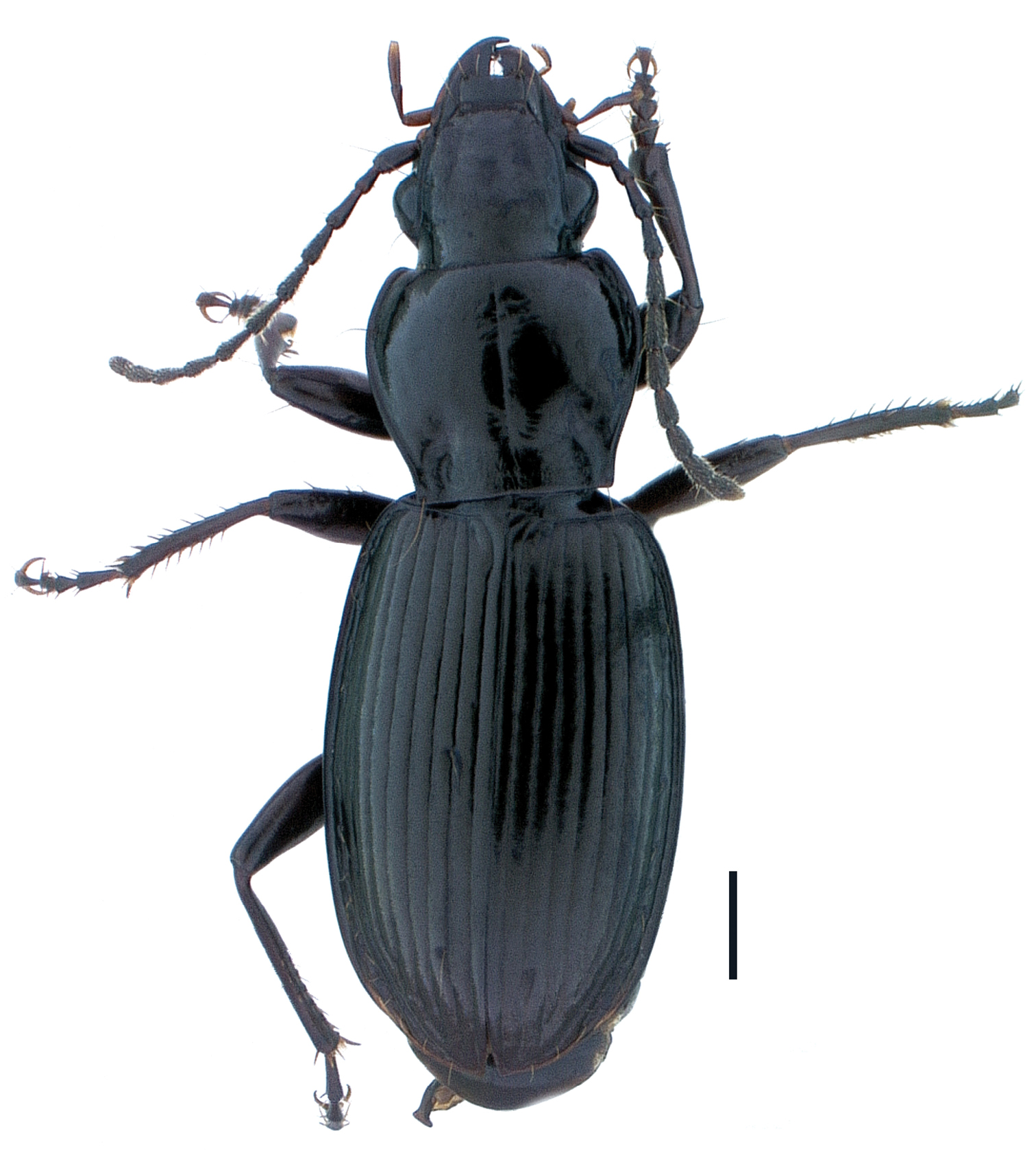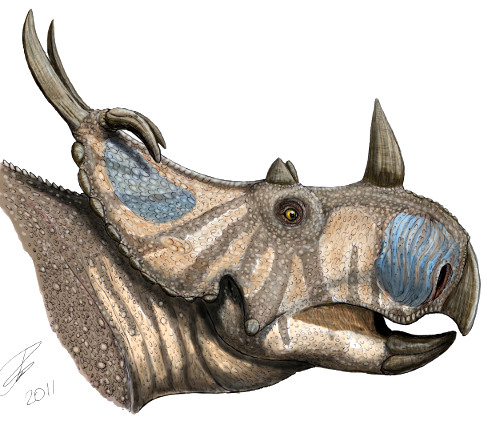… to put the name of your choice on a new species, and have your name become a permanent piece of biological history?

Holotype male, Pterostichus (Pseudoferonina) bousqueti Bergdahl, sp. n., dorsal habitus. Scale line = 1.0 mm. Automontage digital image by D. H. Kavanaugh. (Bergdahl & Kavanaugh, 2011)
The topic of nomenclature for sale arises every now and again, occasionally even making mainstream media. You may recall the story of a recently discovered Australian shrimp, who’s naming rights were auctioned off to the highest bidder on eBay (that bidder turned out to be a professional athlete interested in conservation biology) and the resulting funds donated to marine conservation (McCallum & Poore, 2010). Or perhaps the $650,000 Golden Palace Casino paid to give Callicebus aureipalatii it’s name (that money was also donated to conserving the native habitat of the species).
While the wholesale of species naming rights is relatively uncommon, ask any taxonomist and they’ll likely have an opinion on the subject, often one of caution and fear of abuse. Consider what may happen if the business of species naming becomes as popular as the business of selling star names (which is pretty well a scam by the way; stars aren’t officially named, they’re numbered by the IAU); countless fly-by-night companies splitting the slightest variation to turn a few bucks and causing true taxonomists endless headaches as they deal with an infinite number of synonymies. A pretty simple ruse given the current rules of zoological nomenclature; give a brief description, say you’re depositing the type specimen somewhere, and then provide several public libraries with copies of the descriptions, which don’t even need to be peer-reviewed.
You can see why taxonomists have a vested interest in keeping a close eye on sponsored taxonomy; we have enough true species to find and describe without needing to waste our time dealing with splitting-for-profit names.
While the threat of poor taxonomy is ever present with current ICZN regulations, most taxonomists are extremely underfunded (if funded at all) and would love some extra money to help do their jobs, even if it means providing a patronym.
So why am I bringing up the subject now? Just this week James Bergdahl, an “amateur” taxonomist, posted to the ENTOMO-L email listserv offering the name of a recently discovered ground beetle (Carabidae) for sale. From the email:
The species is a flightless ground-beetle (Coleoptera: Carabidae) in the genus Pterostichus. Adults of the species are primarily black, flightless, and approximately 1 cm in length, and live exclusively along small, forested headwater streams. Similar species have recently been described by Bergdahl & Kavanaugh (2011)*. The species is a member of a closely related group of beetles, restricted in distribution (endemic) to the Pacific Northwest, that have experienced a spectacular radiation across the many coastal and interior mountain ranges of the region.
The minimum offer accepted is estimated to be approximately US$20,000. These funds will be used to support all aspects of wildlife and habitat research by the Conservation Biology Center, including office, travel, lab and publication expenses.
You may think that US$20,000 is a lot of money to ask for naming an obscure, tiny, black beetle, but consider a partial list of the costs associated with taxonomy:
- 15 years of field research to find it (according to the email) – safely assume $500 of expenditures/year (collecting equipment/traps, travel & accommodation costs, etc)
- lab materials for conducting research (pins, drawers, cabinets, microscopes, imaging resources, etc) – $2000+
- publication costs – $250+
- acquisition of taxonomic knowledge necessary to distinguish a new species (literature, museum visits, specimen shipping costs, etc) – priceless
That brings a low end estimate of the cost to describe this species at around $10,000, not including salary and that all-important priceless category, making a $20,000 asking price less incredulous. In fact, it’s been hypothesized that the average cost for describing a species is US$48,500 (Carbayo & Marques, 2011), making this ground beetle a steal of a deal (especially compared to that GoldenPalace.com Monkey)!
While in a perfect world taxonomists wouldn’t need to prostitute their work to pay the bills, if done responsibly, it may be an alternative mode of rectifying the taxonomic impediment.
So if you or someone you know has an extra $20,000 laying around and would like to help a taxonomist disseminate his knowledge, why not contact James and become a part of history?
What do you think of taxonomic funding via patronage? Would you consider paying a taxonomist for the honour of naming a species? Leave a comment below!
 Bergdahl, J., & Kavanaugh, D. (2011). Two new species of Pterostichus Bonelli subgenus Pseudoferonina Ball (Coleoptera, Carabidae, Pterostichini) from the mountains of central Idaho, U.S.A. ZooKeys, 104 DOI: 10.3897/zookeys.104.1272 (OPEN ACCESS)
Bergdahl, J., & Kavanaugh, D. (2011). Two new species of Pterostichus Bonelli subgenus Pseudoferonina Ball (Coleoptera, Carabidae, Pterostichini) from the mountains of central Idaho, U.S.A. ZooKeys, 104 DOI: 10.3897/zookeys.104.1272 (OPEN ACCESS)
Carbayo, F., & Marques, A. (2011). The costs of describing the entire animal kingdom Trends in Ecology & Evolution, 26 (4), 154-155 DOI: 10.1016/j.tree.2011.01.004
ANNA W. McCALLUM, & GARY C. B. POORE (2010). Two crested and colourful new species of Lebbeus (Crustacea: Caridea: Hippolytidae) from the continental margin of Western Australia Zootaxa, 2372, 126-137 Preview Here
<span class=”Z3988″ title=”ctx_ver=Z39.88-2004&rft_val_fmt=info%3Aofi%2Ffmt%3Akev%3Amtx%3Ajournal&rft.jtitle=Trends+in+Ecology+%26+Evolution&rft_id=info%3Adoi%2F10.1016%2Fj.tree.2011.01.004&rfr_id=info%3Asid%2Fresearchblogging.org&rft.atitle=The+costs+of+describing+the+entire+animal+kingdom&rft.issn=01695347&rft.date=2011&rft.volume=26&rft.issue=4&rft.spage=154&rft.epage=155&rft.artnum=http%3A%2F%2Flinkinghub.elsevier.com%2Fretrieve%2Fpii%2FS0169534711000176&rft.au=Carbayo%2C+F.&rft.au=Marques%2C+A.&rfe_dat=bpr3.included=1;bpr3.tags=Biology%2CTaxonomy”>Carbayo, F., & Marques, A. (2011). The costs of describing the entire animal kingdom <span style=”font-style: italic;”>Trends in Ecology & Evolution, 26</span> (4), 154-155 DOI: <a rev=”review” href=”http://dx.doi.org/10.1016/j.tree.2011.01.004″>10.1016/j.tree.2011.01.004</a></span>


